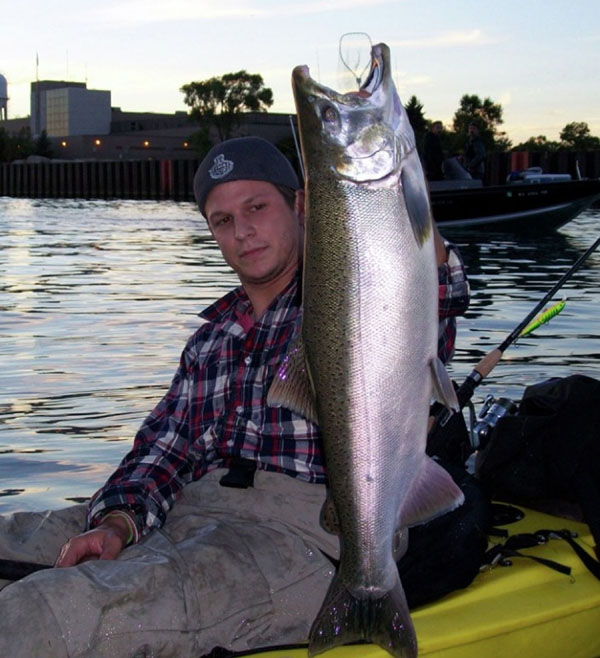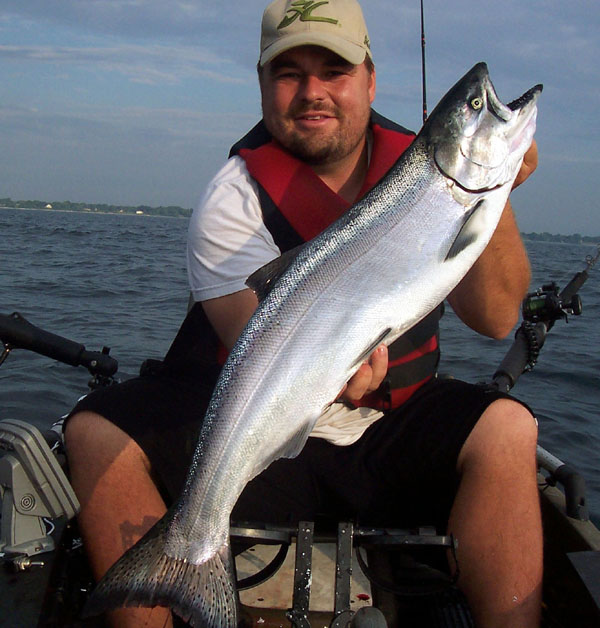By: Rob Wendel – Date Posted: July 19, 2011
Are you bored with your typical summer fishing routine? Are you looking for a bigger thrill next time you go fishing? Kayak fishing for King salmon will undoubtedly satisfy your cravings for adventure and force you to think outside of the box. Kayaks break all the rules when it comes to Lake Michigan fishing. Loads of expensive equipment and huge gas guzzling boats are no longer necessary making salmon fishing affordable and rewarding.
Most people stereotype kayaks as tipsy little boats that are only good for paddling on small rivers. Modern kayaks however, evolved into super stable and roomy fishing platforms that provide comfort and ample space for gear. These little boats perform well on the big water just as they do on small lakes and streams. In fact, anglers utilized kayaks for large game fishing on the ocean years before anyone tried it on the Great Lakes.

Before you grab a kayak and start paddling into the horizon some precautions need to be taken. First, a life jacket should be worn at all times. In many states, safety regulations for kayaks are very lenient but that does not mean you should be lenient as well. Here is a quick list of essential safety equipment all anglers should have before venturing onto the lake.
- Flares
- Hook cutters
- Hand-held VHF Radio
- Compass
- Cell Phone
- Knife
Now that the all important yet extremely boring gear is covered, it is time to talk about some actual fishing gear. Kayaks come in many shapes and sizes, but the preferred style of kayak anglers are sit-on-tops. Look for a kayak that is stable, has ample storage space, and has good areas to mount accessories like fish locators and rod holders. Sit-on-top kayaks fit the bill and most are self bailing. The most popular fishing kayaks are Hobie Mirage kayaks. These boats are the best of the best when it comes to fishing. They provide tons of storage options, great stability, and the Mirage Drive allows anglers to pedal for hands free fishing. The kayak’s length should be between eleven and sixteen feet long for Lake Michigan. Get the longest kayak you can store or afford as longer is better. Longer kayaks are faster and track better so covering large expanses of water is much easier.

Once you have your kayak it is time to start rigging it. Most kayaks designed for fishing come with rod holders built in but adding a couple of Scotty or Ram Mount rod holders will allow you to keep your rods in better positions and more parallel to the water. It is important that your diver rods are in a horizontal position. This allows the diver to get to the desired depth with less line and is less stressful on the rod when a fish hits. Fish locators are also important to successfully finding kings. Sure an angler can catch fish with out one, but when miles of fishless water need to be eliminated in order to find salmon, fish locators can be very useful.
When it comes down to the bare essentials like rods and reels, there are two views. Some like to keep simple. They use a couple of medium action spinning rods with medium to large spinning reels and drag around Hot-n-Tots or other similar baits. Others prefer to utilize divers and planers for a more diverse spread. This requires bait casting or trolling rods that are medium to medium heavy action with bait casting or trolling reels that can handle the added resistance of the divers. Abu Garcia Ambassadeur size 5500 or 6500 work fine but for added precision try line counters like Okuma Magdas or Convectors in sizes 15 or 20. Bigger reels are necessary when using leadcore line due to its large diameter. Rod length depends on the length of your kayak. It is important that the rod can reach around the bow of the boat while fighting a fish. I like to use twenty to thirty pound braid on my reels. Braid’s strength and small diameter make it perfect for the various divers available. Mono tends to be thick requiring much more line out to achieve the desired depth.
When it comes to divers, there are many available. For beginners, Jet Divers are a great option. They are easy to use and can get down to where the fish are easily. They also float so anglers can stop moving without worrying about baits sinking and getting snagged. Dipsy Divers are more effective since they are directional. They get your bait down and out away from the kayak so you can spread out your baits and cover more water, but they create more drag in the water and sink quickly if stopped. Torpedo Divers are another great tool for getting your baits deep. They are very hydro-dynamic so there is very little blow back. I like to use the Cuda Torpedo Diver which is quite heavy. Depth charts show that there is almost a one to one ratio of feet of line out to depth for the first forty feet down. In essence it is a downrigger for your kayak making depth control very precise. Leadcore line is also very effective for catching salmon. It gives baits an action that Kings find hard to resist. Like the torpedo diver it has very little drag in the water for an easy paddle but needs a lot of line out to get deep. It also lacks versatility. Rod tips can wear at the leadcore’s coating weakening it over time. To prevent this, all of the leadcore must be let out past the rod tip so all that is left on the rod is the backing. So, if a reel contains five colors of lead it can achieve a depth of twenty to twenty-five feet, but can not be made shallower with out cutting off some of the line. Adding weight can make it deeper but is often difficult to handle in a kayak.
I often employ a combination of any three of these rigs. Sometimes it is a dipsy of each side and a leadcore down the middle. Other times it is a dipsy, torpedo diver and a leadcore. It all depends on how deep I need to get my baits and the selection of baits I am using. One simple program for beginners is to use two rods, one with a Jet Diver and the other with a Dipsy Diver. If your rod holders are positioned in front of your body and you are using right handed reels, you will have one reel handle facing you and the other facing way. Put the Jet diver on the rod with the handle facing away and the dipsy on the rod with the handle facing you. If a fish hits the dipsy diver you can leave the jet diver in the water with out it getting snagged. If a fish grabs the Jet Diver rod you can always crank in the Dipsy with one hand while it is in the holder so it does not get snagged. It may sound difficult to use the different divers out there but with a little practice they become easy to use and allow you to use a wider array of baits.

Spoons and plugs are two of the easiest and most effective baits to use when fishing for salmon. They are both very speed tolerant which is important while trolling from a kayak. They also come in a variety of sizes. Salmon are very size oriented. They will key in on specific sizes of baits often dependent on the size of the forage in the area. Matching the hatch is vital, so try to have a variety of sizes and colors. Color selection changes day to day but baits with combinations of blue, green, chartreuse, pearl, silver, or glow are good places to start. Of course, lure color does not matter if there are no fish around.

The first rule of fishing is to fish where the fish are. This is a daunting task on the wide expanses of water in the Great Lakes. Cold water is a key factor in finding salmon so good places to start are areas with deep water near shore. This creates a good opportunity to find cold water with out traveling long distances off shore. Consecutive days of offshore winds will cause an upwelling of cold water near shore. Upwellings bring in loads of bait and feeding Kings. If the area you want to fish has points, humps, or ledges adjacent to the deep water it is even better as bait will often be near by.

King salmon are eating machines. Their high metabolism requires them to feed multiple times a day so finding forage is very important. Unfortunately, on some days, salmon have a way of hiding from your fish locator’s transducer even when they are in the area. Temperature probes like the Fish Hawk TD make it easy to key in on the right depth. It will show you the water temperature in the entire water column and how deep you bait is really getting. Knowing where the thermocline is in the water column will help you keep your baits in productive water. Look for water that is below fifty-five degrees and keep in mind that colder is better. Start with your baits at or below the thermocline. A good place to begin setting your lines is one at the thermocline, one half -way to the bottom from the thermocline, and one near the bottom.
I will look for the coldest water possible unless it seems the forage moved into warmer water. Sometimes the forage prefers to stay closer to structure even if it means tolerating slightly warmer water. This often occurs during low light periods. The food chain is very active during these times. Alewives will rise in the water column or move in shallow to feed on plankton and the kings will be right there to take advantage of the distracted prey. Low light is a great time to bring out the glow in the dark baits. It is also effective to forget the rules about matching the hatch and just use magnum size baits. Get ready for some fast action. These kings will really put your abilities to the test and take you for a ride!

A mature king salmon can easily pull a kayak several hundred feet before tiring. It is important to keep the boat pointed toward the fish. Windy days make it difficult but are the most important times to control the direction of the kayak. Keep the rod tip pointed toward the bow. The fish will pull the bow of the boat in its direction so the kayak will always point to the fish. Anglers with pedal kayaks can maneuver around the fish to keep the other lines moving. This will keep the other baits off the bottom and increase the chance of getting a double.
Every angler should experience catching salmon from kayak. The thrill is unsurpassed and addicting but do not rush out on the water. Choose your days wisely and make sure others are with you or know where you are.
Rob Wendel is a 3rd generation fisherman, originally from Arlington Heights, IL. Since catching his first king salmon from kayak in 2005, Rob has fished almost exclusively from a kayak. He currently promotes the sport through teaching anglers how to fish from kayaks and is also a member of the Hobie Pro Kayak Fishing Team. You can visit Rob online at www.greatlakeskayakangler.com






